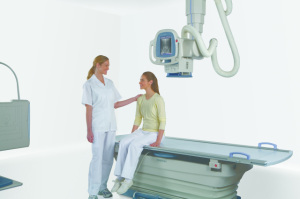by
Keith Loria, Reporter | February 19, 2011

Toshiba RADREX
Mixed Detector System
From the January/February 2011 issue of HealthCare Business News magazine
It wasn’t that long ago when X-ray departments at hospitals and medical imaging facilities were contemplating whether to transition from their analog systems to computed radiography, direct digital radiography or a combination of both.
Now it looks as though DR will be the answer for more hospitals than previously anticipated thanks to lower price points over the last year.
Some, such as Shawl Lobree, VP of marketing for Philips Healthcare’s diagnostic X-ray business, believe CR has finally run out of road. “For the medium and large hospitals in the United States, I think CR purchases are really going to plummet,” he says. “CR sales have been shrinking and we are seeing that trend. The CR purchases we are seeing now are in outpatient centers or ICUs as hospitals are going away from big CR purchases.”
Others, like Eileen Heizyk, worldwide marketing manager for Carestream Health, believe CR still has some life to it but acknowledge DR is edging it out. “Both are still growing and there are still applications all over the world where we need to help our customers move into the digital world,” she says. “DR is experiencing double-digit growth world wide and though CR is growing at a slower rate than it has in the last five to 10 years, it is still viable.”
When DR rooms first hit the market, typical prices were in the neighborhood of half a million dollars. Today, a good DR room could be had for about half that amount.
“DR is starting to approach the pricing of CR with all the competition,” says Rob Fabrizio, senior product manager of modality solutions with Fujifilm Medical Systems U.S.A. Inc.
Portable DR and wireless
The market’s interest in portable DR has been noted by many manufacturers and some of the market is growing. For years, GE Healthcare had the lion’s share of the DR mobile market with its AMX family of products. In 2003, Canon USA, Inc. became the first on the market with a wireless DR portable. That was followed in 2005 by GE upgrading its AMX products with a wireless detector. This year, Agfa HealthCare will release its portable DR, the DX-D 100.
“Today’s buzz is all about wireless detectors and that’s really where the industry is going,” says Boris Geyzer, senior specialist of product sales for Canon. “The next great thing is going to be with DR mobile."
An explosion in wireless detectors over the last year has resulted in a flexible, easy transition to DR from existing analog or CR. Even for those hospitals that already employ a DR room, wireless provides the perfect complement to allow a portable DR detector in a cassette size that can be used for cross-table work and wheelchair exams.
